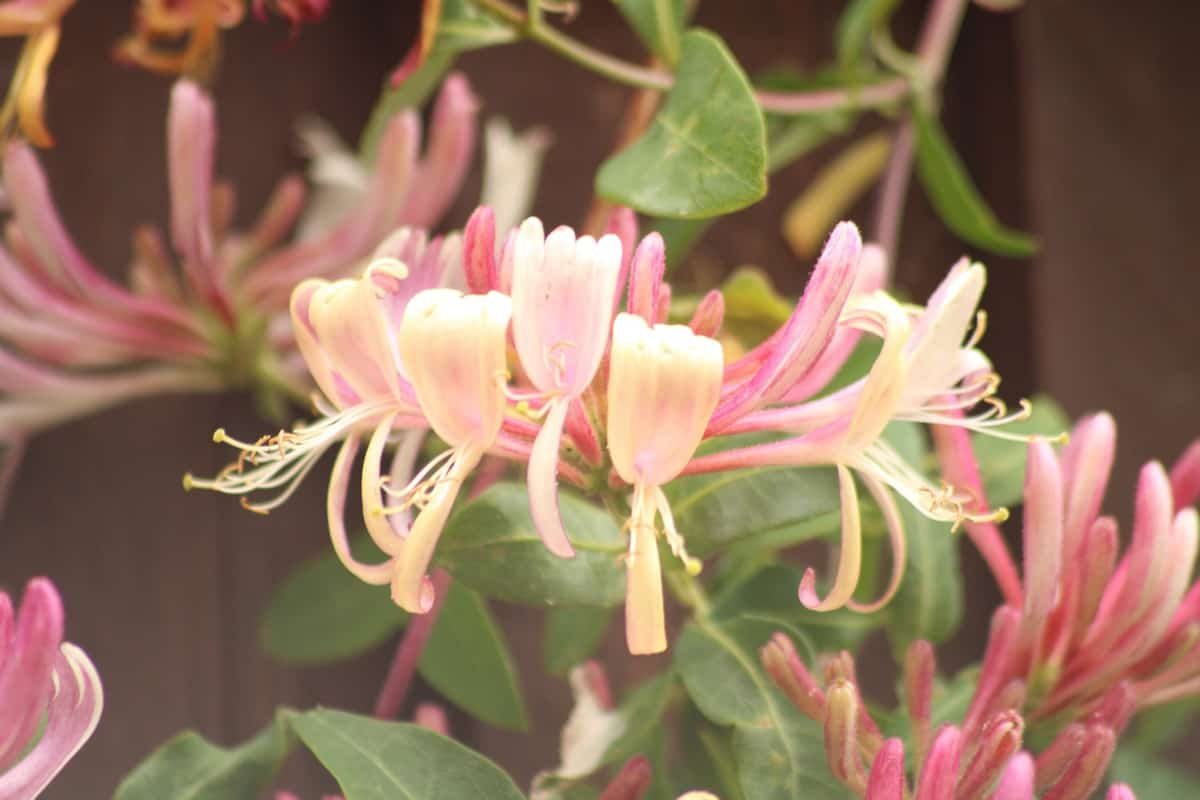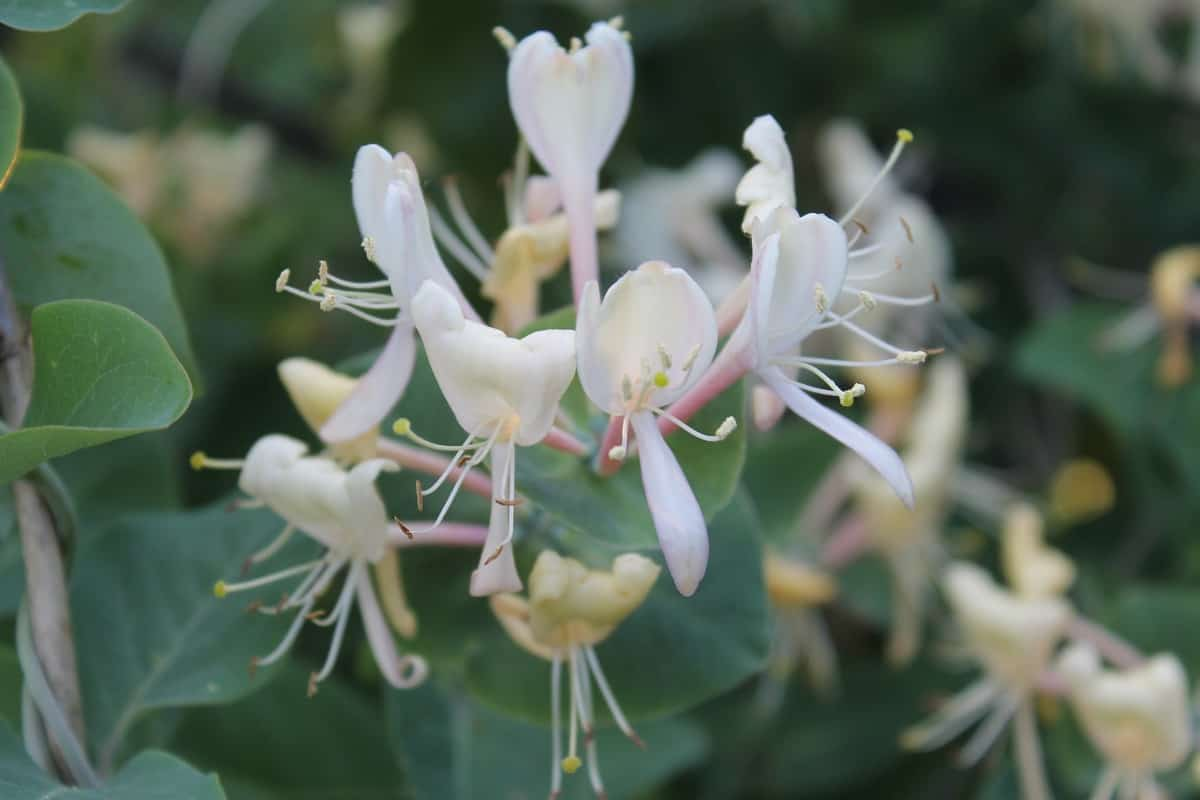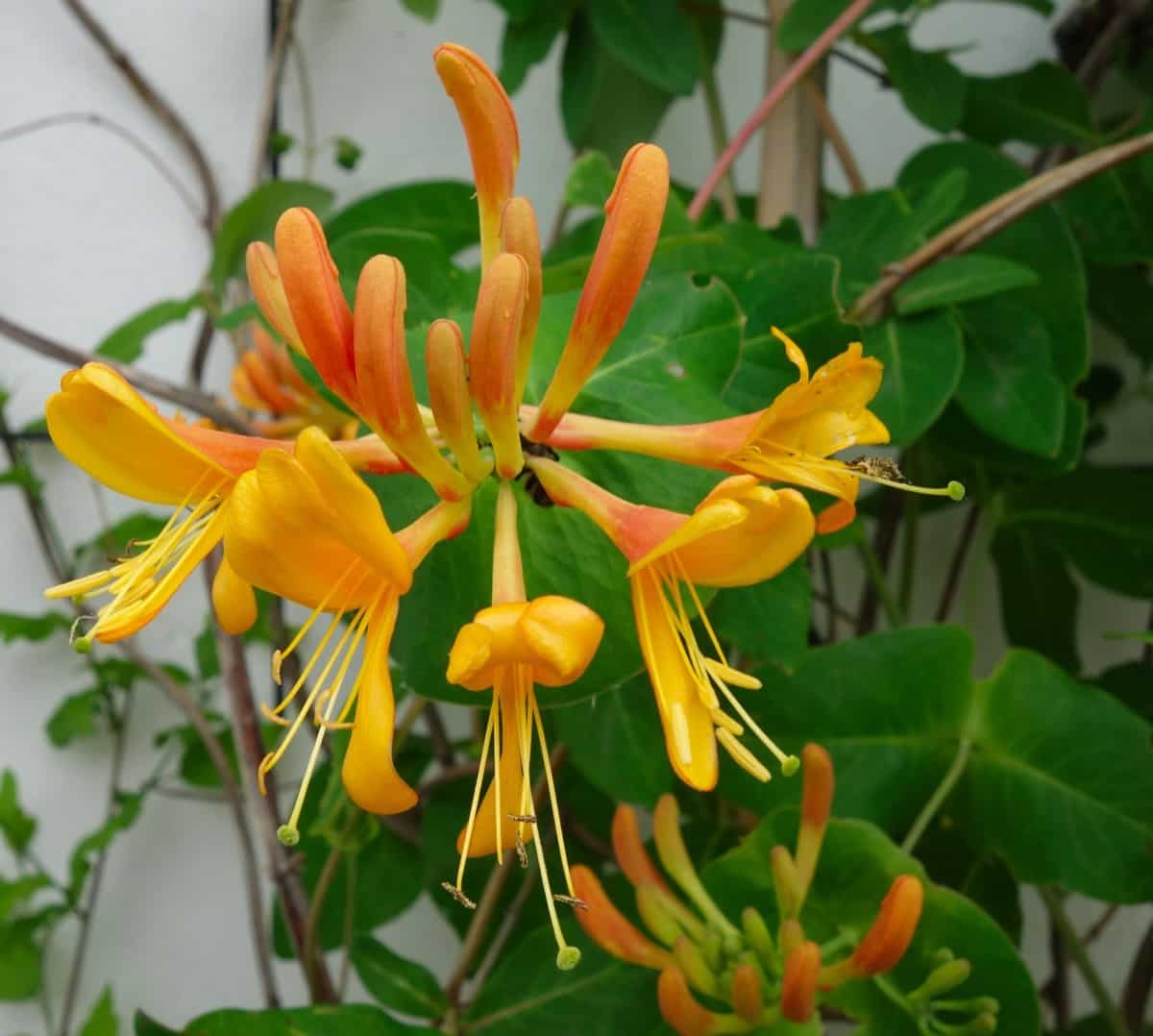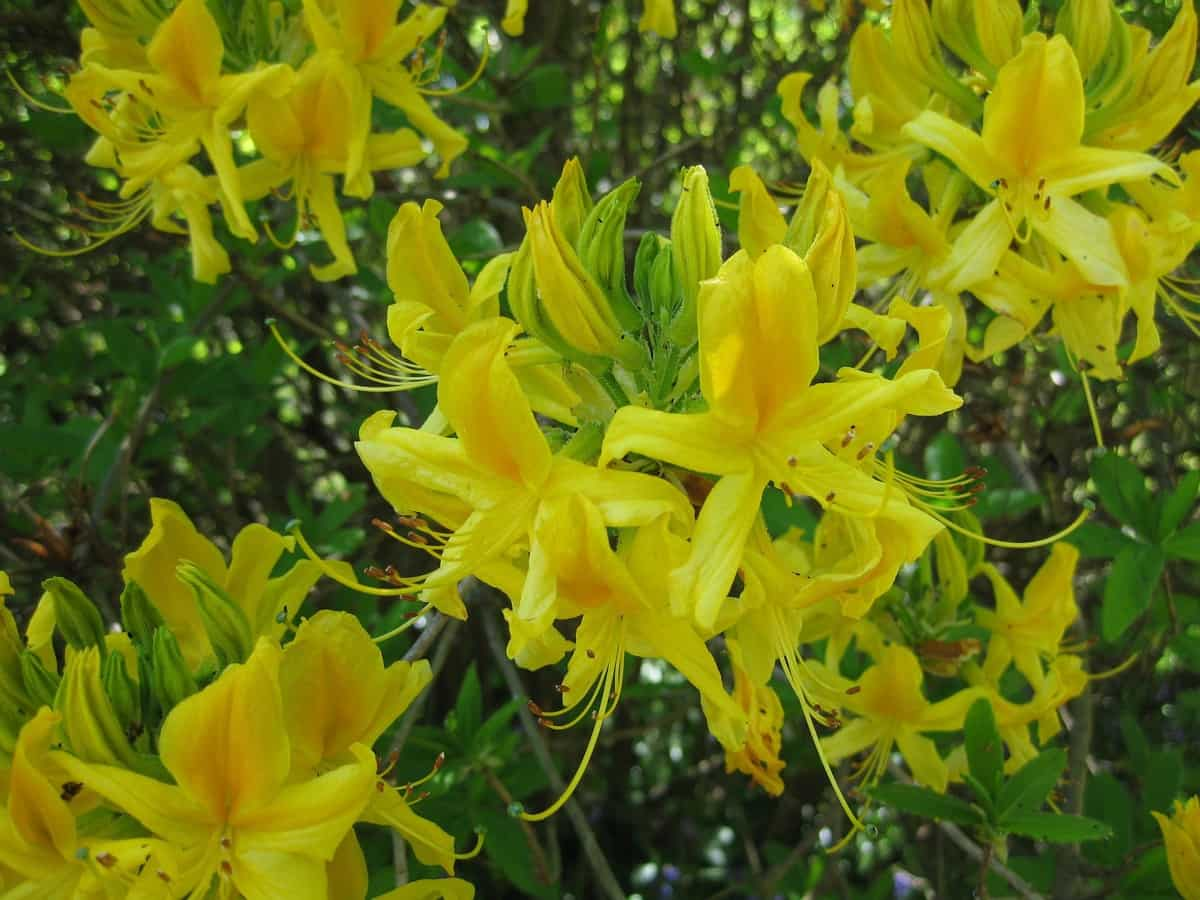If you’re looking to add beauty to your yard with a fast-growing, fragrant vine, look no further than Honeysuckle. This flowering plant comes in many easy varieties to grow and care for. This hardy plant can thrive in various conditions. The vine produces clusters of small, trumpet-shaped flowers that are very fragrant.

Honeysuckle is a popular garden choice because it is easy to care for and blooms from late spring through summer. When choosing a planting site for your Honeysuckle vine, ensure it has enough space to spread out. Honeysuckle vines can reach up to 20 feet in length, so give them plenty of room to grow. Trellising or fencing will help support the vine and keep it under control.
How to grow and care for Honeysuckle
Types of Honeysuckle plants
- Alpine – There are many types of Honeysuckle, but the Alpine variety is one of the most popular. The Alpine Honeysuckle is a vigorous climber with long, thin stems. The leaves are dark green and oval-shaped, with a smooth texture. The flowers are small and white, flowering from June to August.
- Box – This type of Honeysuckle is a fast-growing, deciduous shrub that can reach 6 feet in height. The small and white flowers bloom in clusters from May to July.
- Browns –There are many types of Honeysuckle, but Browns are perhaps the most unique. These Honeysuckles get their name from their characteristic brownish color. It has clusters of small, yellowish-brown flowers. The flowers are very fragrant and attract bees and other pollinators. This type of Honeysuckle is tolerant of most soil types. It needs full sun to partial shade, and once established, it is quite drought tolerant.
- Gold Flame – Gold Flame Honeysuckle has arching branches covered in small, tubular flowers that bloom from June to August. The flowers are pinkish-red on the out and yellow on the inside. The leaves of Gold Flame Honeysuckle are dark green and have a slightly wrinkled texture.
- Japanese – There are many types of Honeysuckle, but Japanese is one of the most popular. The Japanese Honeysuckle has sweet-smelling white flowers that bloom in the spring and summer.
- Privet – It is a twining vine that grows to 10 feet in length, with oval, green leaves and small, white flowers borne in clusters.
In case you missed it: How to Grow and Care for Living Stones/Lithops

Climate suitable for growing Honeysuckle
The climate suitable for growing Honeysuckle is not too hot or cold. The plant does best in temperatures between 15 to 21°C. If the temperature gets too hot, the leaves will scorch, and the plant will not produce as much flowers. If the temperature gets too cold, the plant may die. The perfect time to plant Honeysuckle is in the spring or fall. Be sure to choose a location that gets full sun and well-drained soil. Honeysuckle will grow in partial shade, but it will produce more flowers if it receives 6 to 8 hours of direct sunlight daily.
Soil requirement for growing Honeysuckle
Honeysuckle can be grown in various soils but prefers well-drained, loamy soil high in organic matter. If your soil is clayey or sandy, add organic matter to help improve its texture and drainage. When it comes to soil requirements, Honeysuckle is not particularly picky. Avoid planting Honeysuckle in wet or waterlogged soils, as this can lead to root rot.
Honeysuckle is a vigorous, twining vine that tolerates various soil types and conditions. It will grow in poor, dry, rich, and moist soils but performs best in well-drained loams with a slightly acidic pH. If your soil is heavy clay or alkaline, you can improve its drainage and acidity by amending it with organic matter such as compost or peat moss.
Water requirement for growing Honeysuckle
- Honeysuckle requires a lot of water to grow, so be sure to water your plant regularly. A good rule is to water your plant once a week, ensuring the soil is moist. Honeysuckle is a hardy, fast-growing plant that can thrive in various conditions. However, like all plants, it has certain water requirements that must be met to stay healthy and flourish.
- To ensure your Honeysuckle plant has enough water, check the soil around it every few days. If it’s dry to the touch, give the plant a thorough watering. During hot, dry weather, you may need to water daily. In general, Honeysuckle needs about 1 inch of water per week. This can come from rainfall, irrigation, or a combination of both. If you live with little rainfall, you must supplement with irrigation. The best way to water your Honeysuckle is to soak the ground around the plant deeply and then allow it to dry before watering again. This encourages deep root growth and helps the plant withstand drought conditions better.
In case you missed it: How to Grow and Care for Rhododendrons: A Beginners Guide

Propagating Honeysuckle
From cuttings
Honeysuckle is best grown from cuttings taken in late summer. To take a cutting, you should use a sharp knife or pruning shears to snip a 6-8 inch stem from the tips of the plant. Make sure to choose a healthy stem section with plenty of leaves. Once you take the cutting, you should remove the bottom leaves to have a bare stem about 4 inches long. Next, dip the cutting end in the rooting hormone and plant the cutting in a pot. Keep the cutting well-watered and in bright indirect light until new growth appears. This can take anywhere from 2-4 weeks.
From seeds
Growing Honeysuckle from seed is not difficult, but it takes patience. First, the seeds must be stratified, exposing them to cold temperatures for some time before germinating. The perfect time to sow the seeds is in late fall or early winter. To stratify the seeds, mix them with moist sand and put them in a zip-top bag.
Then, keep the bag in the refrigerator for two to three months. Check on the seeds periodically to make sure the sand is still moist. Once the stratification period is over, sow the seeds in pots filled with quality potting soil. Place the pot in a sunny spot. The seeds should germinate within four to six weeks. Once they sprout, thin out the seedlings so that each pot has only one or two plants. Care for young Honeysuckle plants is relatively easy.
In case you missed it: How to Grow and Care for Ageratum Plant: A Beginners Guide

Transplanting Honeysuckle seedlings
To transplant Honeysuckle seedlings, choose a location in your garden that gets full sun to partial shade. Prepare the planting bed by tilling the soil to 12 inches and removing any weeds or debris. Next, dig a hole 2 to 3 times wide as the root ball. Gently loosen the roots around the root ball with your fingers. Water generously to settle the roots into their new home. Finally, mulch around the bottom of the plant to help retain moisture and control weeds. When watering, be sure to avoid wetting the leaves of the plant to prevent foliar diseases.
Honeysuckle plant care
Fertilizer requirement for growing Honeysuckle
- Honeysuckle is a fast-growing vine that can reach 20 feet in length. It can tolerate various soil conditions but prefers well-drained soil high in organic matter. Honeysuckle will also do best in full sun to partial shade. When it comes to fertilizer, Honeysuckle is not a heavy feeder. Therefore, if you are growing it in rich soil, you may not need to fertilize it at all. However, if your soil is poor, you can fertilize your Honeysuckle once or twice a year with a balanced fertilizer such as 10-10-10.
- Honeysuckle is a fast-growing, easy-to-care-for vine that’s perfect for beginning gardeners. The key to success with Honeysuckle is providing the right amount of fertilizer. Be sure to water the plant deeply after applying fertilizer to help release nutrients into the soil. Also, avoid getting fertilizer on the plant leaves, which can cause burning.
Pruning Honeysuckle plant
If you want to enjoy the sweet scent of Honeysuckle in your garden, you must take care of it properly. During late winter or early spring, cut back any dead or damaged stems. Then, cut back all the stems by about one-third. Pruning Honeysuckle is an important part of keeping this vigorous plant within bounds. You’ll need to prune it regularly to control its size and shape. You should sterilize your pruning tools before you start to prevent the spread of disease.
In case you missed it: How to Grow and Care for Baby Toes Succulent: A Beginners Guide

Honeysuckle plant care in winter
If you live in cold winters, you may need to protect your Honeysuckle plants from the cold. One way to do this is to cover them with a layer of mulch in the fall. Another option is to plant them in containers that can be brought indoors during winter. When the weather turns cold, Honeysuckle care becomes more important than ever.
This hardy plant can withstand quite a bit of cold, but you can do a few things to help it survive the winter months. First, make sure to water your plant regularly. The plant will suffer if the soil is too dry. Too much water can cause root rot. Finally, give your plant extra protection by covering it with a burlap cloth or other fabric. This will help trap heat and moisture, so your plant stays healthy all winter.
Pests and diseases of Honeysuckle and their control
Pests and diseases of Honeysuckle can include aphids, scale, whiteflies, Japanese beetles, and powdery mildew. Control of these pests and diseases can be achieved through various methods, including chemical controls, biological controls, and cultural controls. Aphids feed on the sap of plants. They can be controlled with insecticidal soap or horticultural oil. Scales are small, hard-bodied insects that attach themselves to the stems of plants and suck the sap. They can be controlled with insecticidal soap or horticultural oil.
Whiteflies are small insects that feed on the sap of plants. They can be controlled with yellow sticky traps or by spraying the leaves with water to knock them off. Japanese beetles are destructive pests that feed on the leaves of plants. They can be controlled with traps or by hand picking them off plants and dropping them into soapy water. Powdery mildew can be controlled by removing infected leaves, avoiding overhead watering, and applying fungicides specifically labeled for powdery mildew control.
In case you missed it: How to Grow Pansies from Seed: Care, Planting to Harvest

Conclusion
Growing and caring for Honeysuckle is relatively easy, as the plant is quite resilient. However, a few things to keep in mind to ensure your plant thrives. Make sure to plant your Honeysuckle in well-draining soil and give it plenty of sunlight; water it regularly but avoid overwatering, and fertilize it monthly during the growing season. You can enjoy beautiful blooms all summer long with a bit of care.
- How to Grow Tomatoes Organically at Home: A Comprehensive Guide
- Organic Gardening on a Budget: Low-Cost Methods and Materials
- Gongura Seed Germination and Planting Methods
- Cabbage Seed Germination and Selection
- Broccoli Seed Germination and Selection
- Asparagus Seed Germination and Variety Selection
- Seasonal Flower Gardening: Best Practices for Spring, Summer, Fall, and Winter
- How to Grow Hibiscus from Flower
- Plantation Ideas for Home Decoration: A Beginners Guide
- Flower Garden Designs and Layouts for Beginners
- Planting and Spacing Techniques in Papaya: A Beginner’s Guide
- Growing Gold: Essential Techniques for Planting Pineapples
- How to Make Kalanchoe Plant Bushy: Home Remedies and Solutions
- 11 Reasons Why Your Gardenia is Not Blooming: Home Remedies and Solutions
- Eco Elegance: The Guide to Designing a Drought-Tolerant Landscape
- Gardening on a Slope: Strategies for Hillside Landscaping
- Nourish and Flourish: Top Organic Mulches for Thriving House Plants
- Everything You Want to Know about Indian Mogra Flower: Discover Uses and Growing
- Green Thumb Success: Expert Tips for Cultivating Greenhouse Pumpkins All Year Round
- Maximize Growth & Flavor: The Ultimate Guide to Companion Planting in Herb Gardens
- How to Control Rhododendron Problems Naturally: Home Remedies and Organic Ways to Fix Them
- Natural Magic: The Remarkable Benefits of Cinnamon for Plants
- Best Steps to Revive Dying Tulip with Natural and Organic Treatment
- 10 Reasons Why Your Angel Trumpet is Not Blooming: Remedies and Treatment
- How to Fix Periwinkle Leaf and Flower-Related Problems: Natural Remedies and Solutions
- How to Fix Zinnias Leaf and Flower Problems: Discover Natural and Home Remedies
- Organic Steps to Induce Lemon Tree Flowers: A Comprehensive Guide
- Bloom Booster: Crafting the Perfect Homemade Bougainvillea Fertilizer
- Optimizing Growth: A Guide to Applying NPK Fertilizer for Potted Plants
- 10 Best Homemade Fertilizers for Rubber Plant: DIY Recipes and Application Method
- How to Boost Female Pumpkin Flowers: Effective Steps for More Flowers and High Yields
- Transform Your Indoor Garden: Top Benefits of Pink Salt for Houseplants
- 10 Best Homemade Fertilizers for Peacock Plants (Calathea): Easy DIY Guide
- Unlock Blooms: 9 Reasons Why Your Potted Chrysanthemum is Not Blooming
- 8 Reasons Why Your Potted Hibiscus is Not Blooming: Fix it with Simple Solutions
- Unlock Blooms: 9 Key Reasons Your Potted Frangipani Won’t Flower